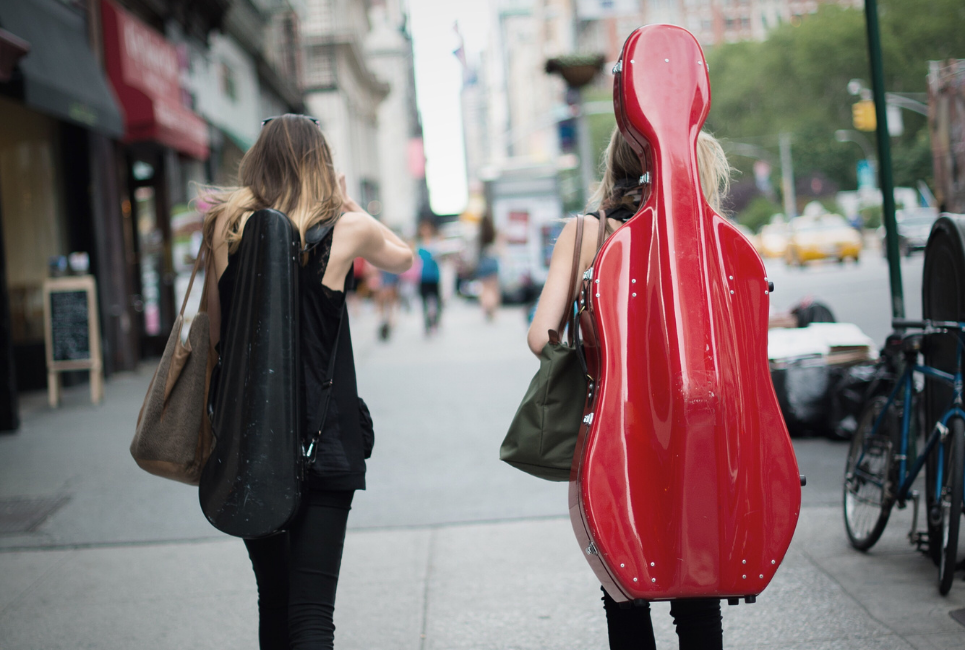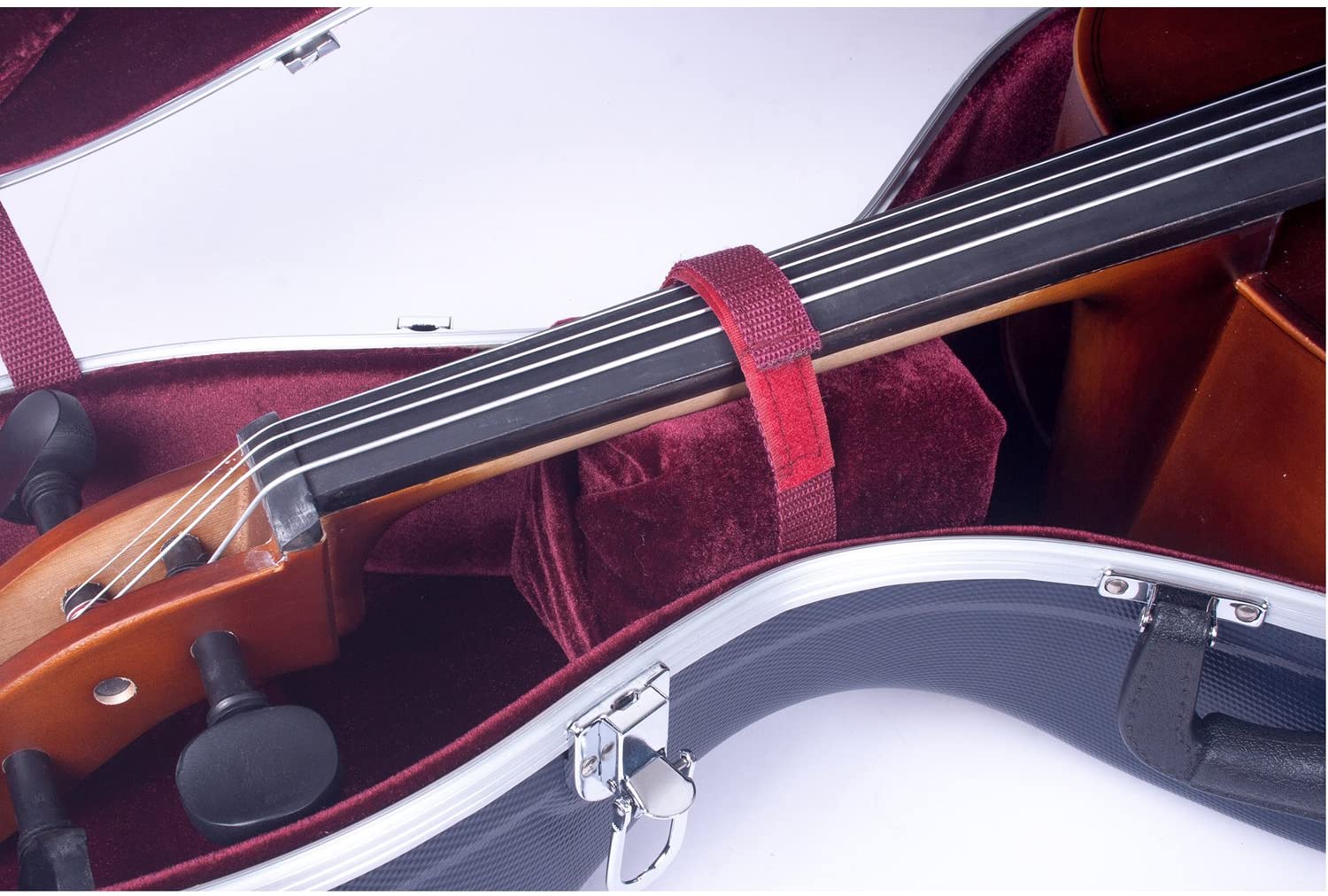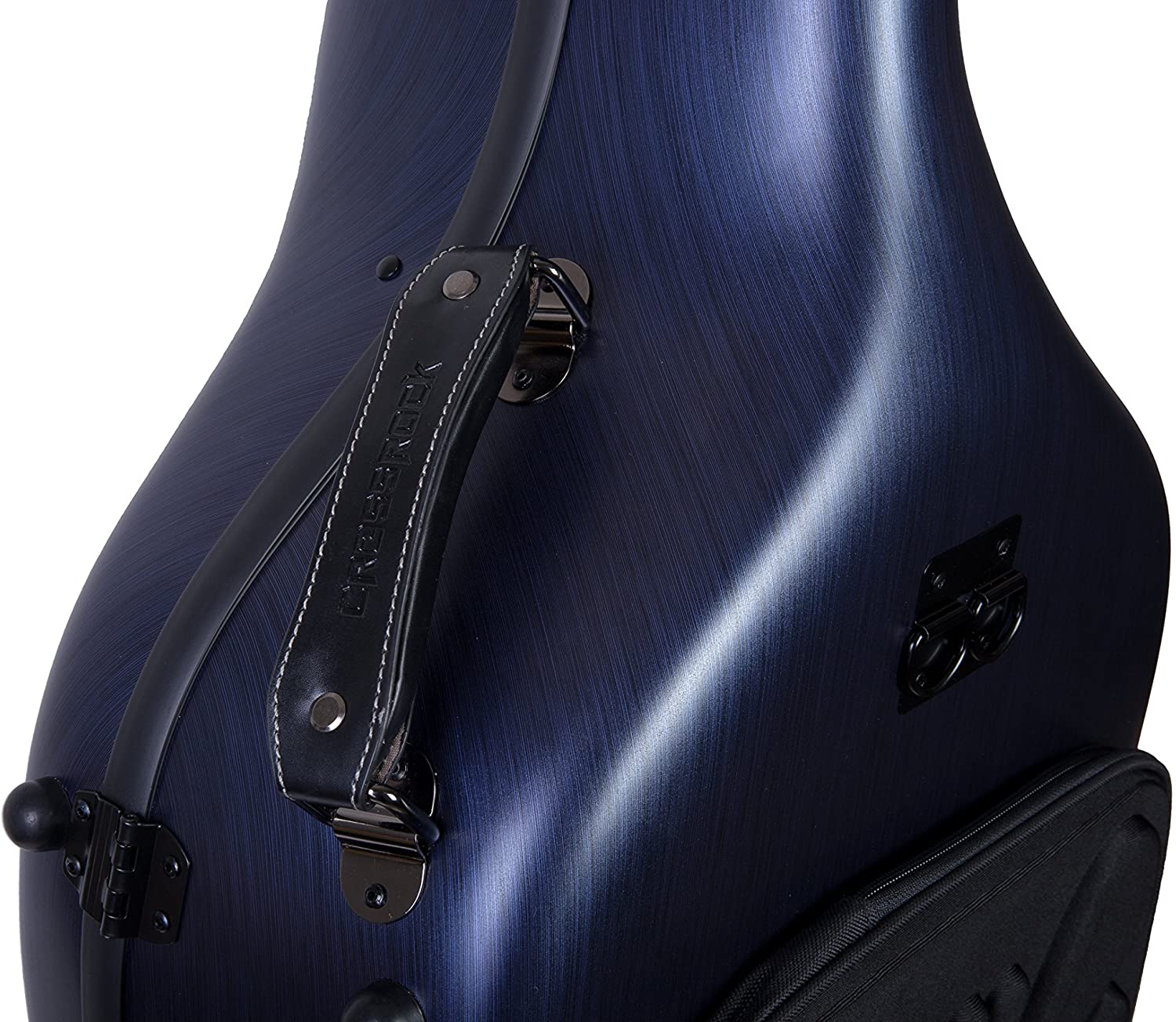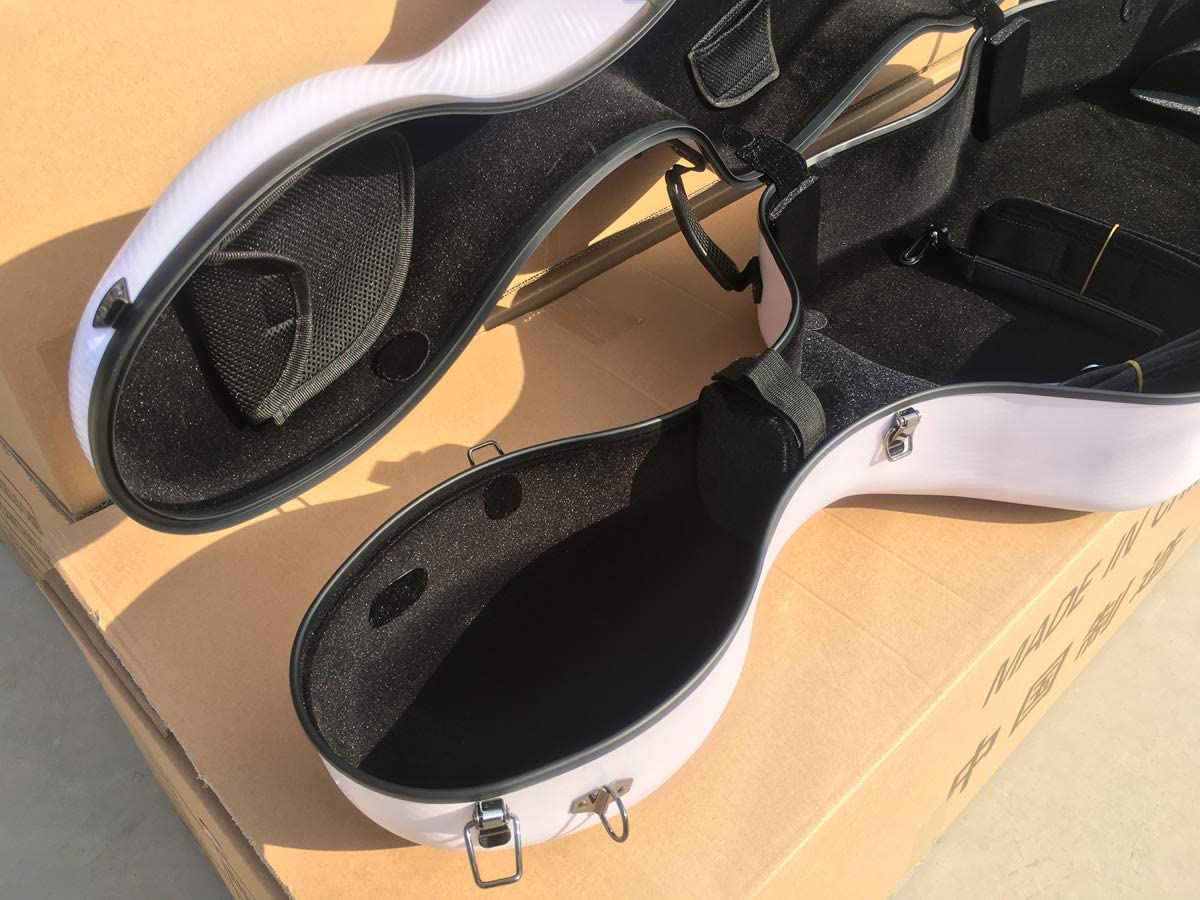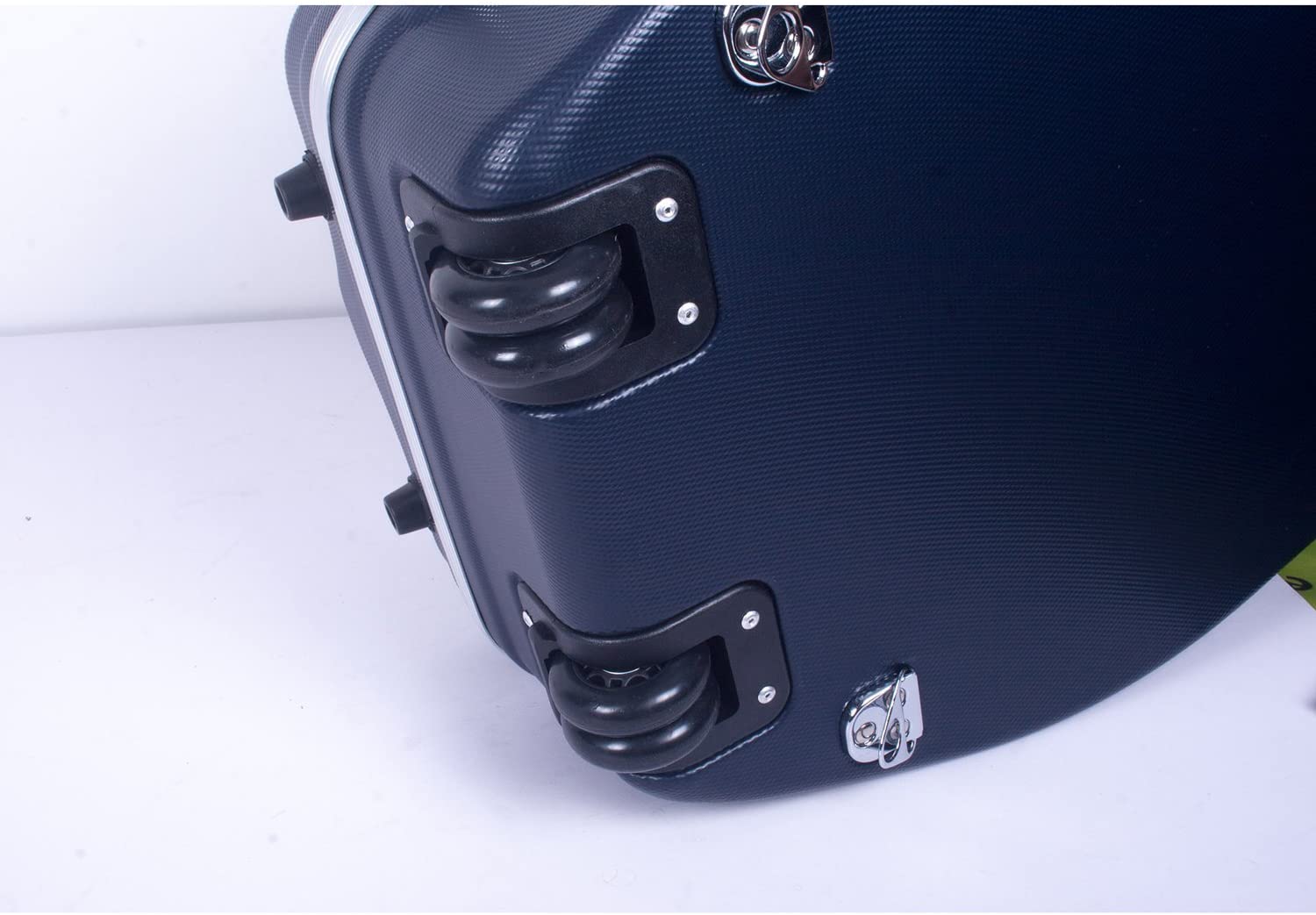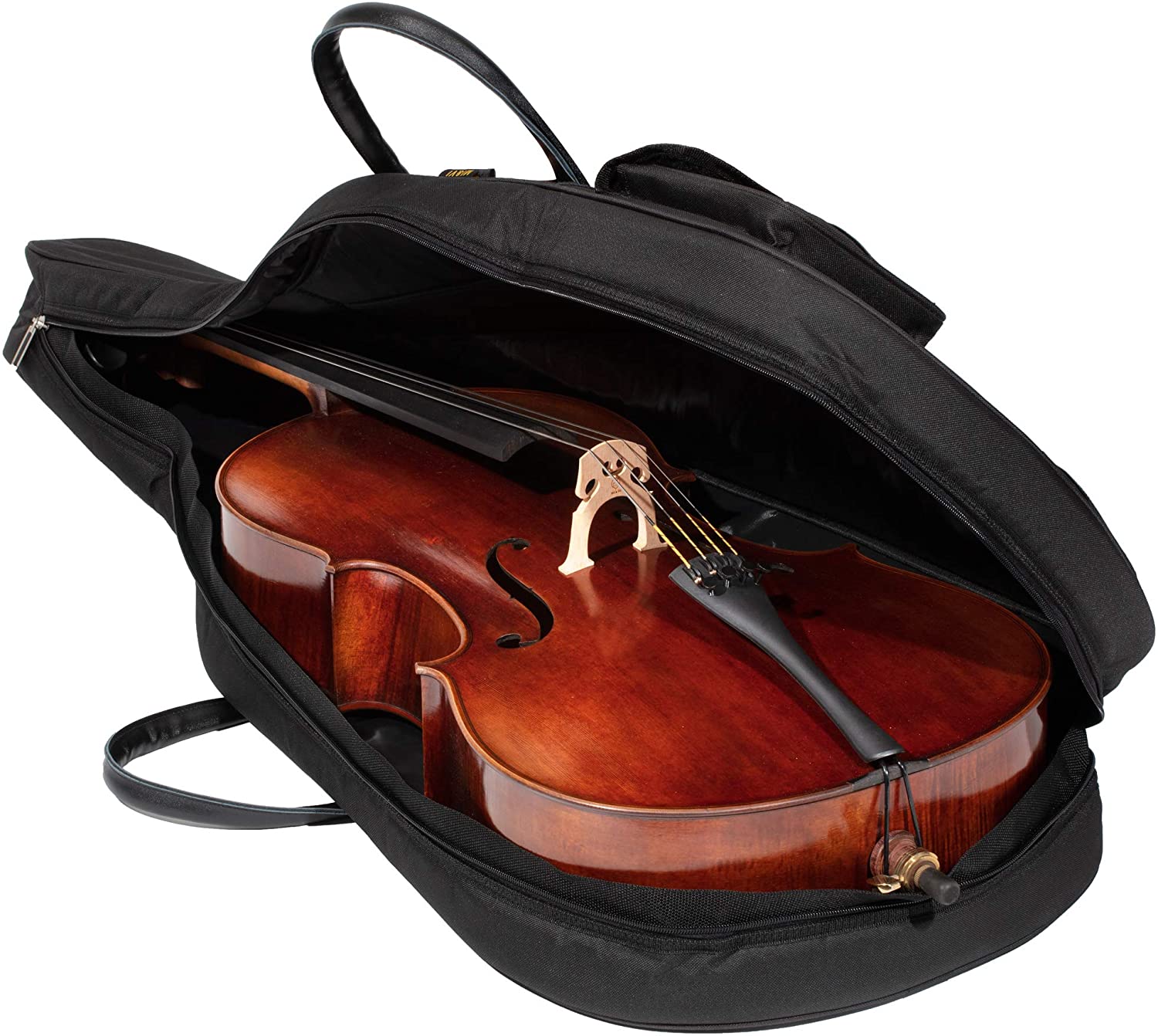- How to Find the Best 5 String Violins - April 21, 2022
- How to Hold a Violin Bow - April 21, 2022
- How to Hold a Cello Bow - April 17, 2022
Summary: Knowing how to find the best cello case means knowing whether you need a case for travel or at-home storage. The proper case will fit your instrument snugly and be easy for you to transport.
After finding the best cello, you need to protect it with the best cello case. Everyone needs a cello case, whether they just started or are traveling for a concert. A cello case protects your instrument from damage, and it gives you a safe place in which to store your instrument so that it does not continually get exposed to temperature fluctuations or dust and dirt in your home. The best cello case is one that fits your needs. But what are your needs? What makes the best cello case?
What You Need in a Cello Case
The best cello case is one that meets your needs. These will differ based on skill level and where/when you play the cello.
| Beginner | Beginners do not often travel with their instrument except to and from lessons once per week, so they need something that offers basic storage and protection at home. |
| Intermediate | Intermediate players often travel a bit more with their cello, like to and from school or group rehearsals, so they need a lightweight case and can be carried in many ways, with padding and storage for accessories. |
| Advanced/Professional | Advanced and professional musicians need something that cradles the cello for rough transit on planes, trains, and cars. They also need a case that has weatherproofing and humidity monitoring built-in. |
You might need:
- Something that can be picked up and carried like a backpack
- Something that has weatherproofing and theft-prevention locks
- Something lightweight
- Something that can be taken on planes and trains without damaging the cello
- Something that gives your cello padding and protection
- Something that has extra storage for all your musical accessories
Who Should Find the Best Cello Case?
When I first started playing my instrument, I did not think I needed a case. It had never even dawned on me that a case would protect my instrument from dust and weather changes that would alter the tension on my strings.
I even stored my instrument next to a sliding glass door through which the setting sun came every evening. I could not figure out why it was always dusty (when I open that sliding glass door to let in the fresh air, all the outside pollen and dust landed right on my instrument) or why I had to tune my strings more than other beginners in my class (all that direct sunlight and temperature changes impacted my strings).
The worst part of it was I lived in California. The California sun is particularly harsh compared to other states. After just one summer of being exposed to the direct setting sun in the afternoon, I noticed the wood on the front of my cello was faded compared to the back. The front was bleached by the sun, and now they look like two totally different types of wood.
The dust I could remove. The strings I could tune. But the discoloration I could never take back. After that, I researched and realized I should have stored my cello in a case.
So, who should find the best cello case?
Everyone
- Beginners need to protect their instruments from the weather, from the dust in their homes.
- Beginners and intermediate musicians need to protect their instrument when moving it to and from music classes or carting it around the school.
- Intermediate and advanced musicians need to transport on buses, Subways, trains, cars, and airplanes without their cello getting scratched.
- All musicians need somewhere to safely store their instrument when they are not using it and store the rest of their accessories like their cello bow, rosin, and sheet music. Famous cello players always carry their instruments in cases.
This video shows you how to place your cello in a case and how to properly store it:
Features of the Best Cello Case and Which Ones to Choose
Cello cases come with different features, and some features are more appropriate for beginners versus advanced musicians.
Material
Cello cases are divided into two materials:
- Hard cases
- Soft cases
Hard Cases
Hard cases are hard outside, usually made with carbon composite or fiberglass. The harder exterior protects your instrument so that if you accidentally trip on the subway and slam your cello case into the corner of the wall like I did, it will only leave some paint on the cello case and will not damage your instrument. Hard cases are heavier because of the extra material, but they give the best level of protection.
Soft Cases
Soft cases are great for beginners or at-home storage. A soft case is fabric and gives basic protection and storage at home or on the go. Soft cases are much more affordable, but they do not have extra benefits like weatherproofing and hard locks. You cannot usually take them on a flight.
- Suppose you usually drive to and from your music classes or lessons. In that case, a soft case can easily fit in the trunk or the car’s back seat without damaging your instrument.
- If you usually take public transit, you need a cello case with extra storage, wheels at the bottom. You should invest in a hard case at this point.
- If you plan to fly or travel on cruise ships, you will need a hard case because airlines and cruise lines will not permit a soft case. Hard cases with features like weatherproofing or waterproof sealing and extra locks can keep your cello safe.
Size
When it comes to a cello case, size matters. Hard cases are usually much thicker and wider than soft cello cases because they have extra padding and suspension built inside. If you are investing in a cello case, make sure it is the right size for your instrument. If you have a 1/2 size cello or a 3/4 size cello, you need a 1/2 size or 3/4 cello case.
Interior Features
The most important interior features for a hard case, and to a lesser degree for a soft case, include the suspension. Foam injection suspension is one of the more expensive types. It is there to hold your cello suspended within the case so that no part of your instrument hits or touches the sides of the case. This is particularly important if you travel a lot and your cello gets bounced around under an airplane.
Other than this, to find the best cello case, you might want interior pockets. Some cases come with zipper pockets or button pockets to store sheet music. Hard case designs often have pockets on the inside for your bow, your rosin, and your music, as well as some extra strings. Less expensive soft cello cases usually have one big zipper component on the outside, so it is not waterproof or weatherproof.
For advanced players, some of the more professional-grade cello cases have humidity detectors inside the case, so you can always monitor the humidity levels as you travel and keep the inside temperature stable no matter what is happening outside.
Exterior Features
Exterior features usually include locks or seals, weatherproofing or waterproofing, and pockets.
As I said, depending on the type of material you choose, you might end up with pockets on the outside of your case. This is quite common with soft cases.
Otherwise, the exterior features you might look for will vary based on your skill level. As a beginner, you do not have to worry about your cello getting stolen on an international flight, or do you need something with a waterproof seal and good weatherproofing on the outside.
However, if you are a more advanced musician and you often travel for performances and rehearsals, this will be very important.
You also must consider where you live. If you live in a wet environment along the Northwestern part of the states, regular exposure to rain and moisture in the air can damage your instrument if you do not have a hard-shell case that is waterproof. If you live in Texas in the middle of the desert, a waterproof case is not going to be as important.
How to Pack Your Cello Case
After you have picked the best cello case, you need to make sure that you put your instrument into your case properly. I always thought that you just shoved it in until everything was covered, but I quickly learned that there is a technique or finesse to packing your cello case.
- Adjust your bow and move it aside.
- Place your cello on its side and close the endpin rod
- Place your cello in the case from one end to the other
- Add any rosin, bow, music, or accessories to the folders and pockets
If you are preparing to take a flight, you need to follow these basic steps, but you also must wrap the outside or use certain locks depending on the airline.
Watch this video on how to pack your cello if you are flying:
My Favorite Cello Case Picks
@canadiancellist New cello case unboxing!! #cello #cellistsoftiktok #cellistoftheworld #cellist #cellistlife #music #musician #musiciansoftiktok #musiciansontiktok #musicianlife #unboxing #reveal
♬ original sound – Laura Wakeman
There are a lot of cases out there that can fit a variety of needs. I have chosen something for everyone, whether you just want a great gig bag or looking for the whole package. These cases were chosen based on my experience as a string musician, known and trusted brands, and their reviews.
All Around Top Choice
When choosing my top choice, I wanted to find something that offered both protection and an affordable price tag. The Core CC4100 Cello Case does that just that. Many of the top cases on the cello market are prohibitively expensive and something many must save for. Students need both protection and affordability. The Core CC4100 is made from a high-density polyfoam shell with cushy padding and plenty of storage. It comes in sizes 1/4 to 4/4 and is affordable enough to purchase multiple times. The best part is that it’s pretty lightweight and easy to move around for an inexpensive case, especially for kids.
Pros
- 2 bow holders, small storage pocket, and music storage pocket
- Wheels for times when carrying it is annoying
- Backpack straps for hands-free carrying, great for students on the move
- Only 8lbs makes it easier for small adults and kids to use.
- Affordable
Cons
- Doesn’t offer the same level of protection as other material
- Only available in one color combo, black and blue/grey
Gig Bag Choice
Gig bags or soft cases are a popular choice for students or those who travel in their cars frequently. They are lightweight, maneuverable, and typically have a lot of storage space. However, they offer little in the way of protection against bumps or drops. The Bobelock Soft Cello bag is a popular choice for students due to its low price and quality construction. Bobelock as a brand has been producing high-quality cases for a long time, so you know you are getting something that won’t rip at the seams or use cheap zippers. I particularly like this bag’s bag’s storage and backpack design, along with the lovely bow pocket on the side. This case came with my rental cello, and I found adequate protection at home. I did not have any pets or kids at the time, though, and I’m not sure I would have trusted this gig bag when my dog was a small rowdy puppy.
Pros
- Lightweight
- Lots of storage space
- Backpack design great for traveling or school
- Made from quality material
- Inexpensive and great for students
Cons
- Only great for at-home storage if the cello is kept in a safe room or there are no kids or pets.
- Only available in one color
Hard Case Choice
Gig bags are great, but they don’t offer enough protection for many. Hard cases like the Bam France 1001S have a durable ABS shell with a plush suspension interior that will keep your instrument secure during storage and travel. With two bow holders, a music pocket, and an extra pocket for strings and rosin, you will have all the storage space you need. This case is available with and without wheels. I prefer the case with wheels because it is more maneuverable and only 40 dollars more. To add to the maneuverability of the case, it comes with two anti-slip backpack straps with removable security hooks.
Pros
- 8 latches with an airtight seal for security
- Sturdy construction
- Well-known, time tested brand
- Two handles for easy carrying
- Comes with or without wheels
- It comes in three colors
Cons
- Expensive
- A little heavy
Airport/Travel-Friendly Case
If you are a professional musician, chances are you’ve flown with your cello at some point. You know that checking your cello can be an anxiety-inducing situation. The Bam France Flight cover seeks to solve that by providing extra level protection to your cello while you are flying. It’s not a case on its own but instead a case for your case. After packing up your original cello case, you placed it inside the flight cover and zipped it up. The Bam Flight Cover is made from insulating polyurethane foam and water-resistant nylon fabric. It’ll keep your cello nice and cozy for the entire flight. Think of this case as a 1 st class seat for your cello.
Pros
- Designed to handle the checked luggage search and loading process
- Wheels for ease of use
- It fits all Bam cello cases and most other full-size cases
- A must-have for professionals who travel by plane often, especially internationally.
- Best in class for plane travel.
Cons
- An extra expense on top of an already expensive case
- Bulky and heavy
- Really expensive
Best Lightweight
It seems the lighter the cello case is, the more expensive it is. So I decided if I was going to recommend a lightweight case, I might as well recommend the best. The Accord Ultralight comes in at 4.9lbs, making it lighter than some gig bags but with all the hard case protection. This case is made with a floating-style suspension system and customizable interior pads; your cello will lie in heaven. Your arms and back will also thank you. This case is made entirely from carbon fiber material placed in a mold, heated, and then vacuumed to eliminate any remaining resin, creating a lightweight, incredibly rigid, and strong case. Inside you will find two bow holders and a pocket for strings and rosin. The biggest downside to this case is just how expensive it is; however, any case under roughly 8lbs will be costly.
Pros
- Extremely lightweight, great for public transit and those who walk a lot
- Backpack attachments
- It comes in really cool colors and designs
- Moveable protection pads for a custom fit
- Plenty of storage
- Very durable against drops, bumps, and scratches
Cons
- Incredibly expensive
FAQ
Answer: If you have a child who is just starting with the cello, you can get them a soft bag. Soft bags come with different levels of padded foam or extra material on the inside so you can pick one that has an inch or so of extra padding with a myriad of pockets. Children always misplace things but a soft bag full of pockets gives them a place to keep all music-related items so that misplacing things happen at a minimum. Children can go to and from music school or classes and know that all the things they need are kept safely in one bag. A soft bag is perfect for situations where they only carry it to and from the car or carry it to and from music class.
Answer: The weight of your cello cases is based on the material. Hard cello cases are traditionally made of carbon composite. More advanced (and expensive) models are made with fiberglass. Fiberglass weighs less than carbon composite, and soft bags made of material weigh less than fiberglass. Usually, a hard-shell case weighs an average of 15 pounds. More expensive, fiberglass cases will weigh about 10 lbs. soft bags might weigh only a few pounds. However, to help you or your child with the weight of the cello case, good bags are designed to be transported in multiple ways. This includes having backpack straps on the back so that it can be hoisted onto your shoulders like a backpack, handles along the edges so you can pick it up and hold it in one hand, or wheels at the bottom so you can easily roll it around.
Answer: Cello cases can cost anywhere from $50 for a soft bag to $3000 for a hard case made with top material. The cost will vary based on the material. Other factors that increase or decrease cost include the extra pockets, zippers, weatherproofing, humidity detectors, or locks on the inside and outside. Suppose you are an intermediate or advanced player and need to safely transport your cello for international flights. In that case, you need to spend around $500 or $600 for a hard-shell case with suspension inside. Most airlines will not let you ship a cello under the plane if you do not have a hard-shell case. If you are a beginner or have a beginner in your family, a soft cello bag is just fine.
Conclusion
In conclusion, finding the best cello case means knowing what features you need most. As a beginner, you might need something with lots of pockets and storage, something lightweight, and something that keeps your cello safe while at home. As you advance in your skills and start playing at different venues or practicing more, you might need something durable that can be transported a lot without damaging your instrument.
Looking for more interesting readings? Check out:

